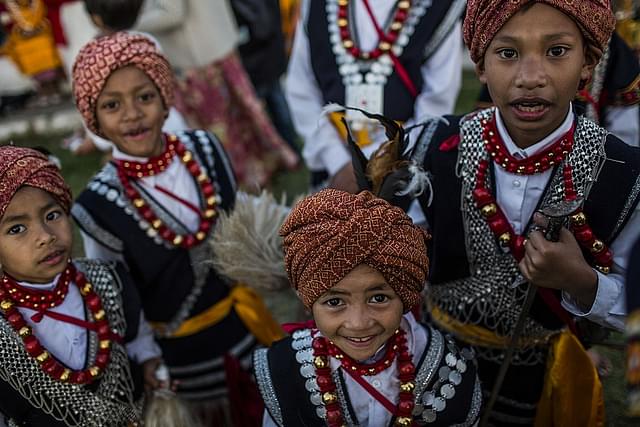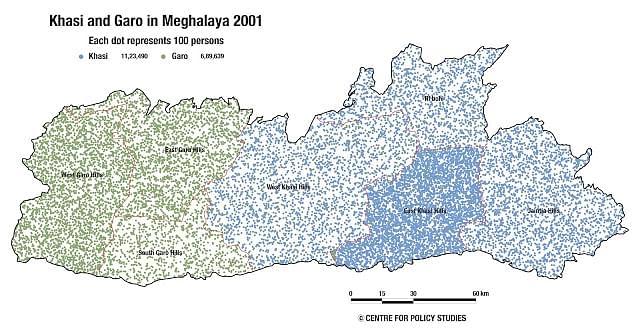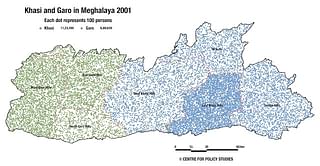Culture
How Meghalaya’s Tribal Culture And Tradition Are Fading Away With Conversions To Christianity
Swarajya Staff
Oct 10, 2016, 05:10 PM | Updated 05:10 PM IST
Save & read from anywhere!
Bookmark stories for easy access on any device or the Swarajya app.

The Centre for Policy Studies (CPS) has published its latest note on the Religion Data Census of 2011. In this note, the CPS analyses the impact of conversion to Christianity on the culture and traditions of the Scheduled Tribes in Meghalaya.
Meghalaya is now a Christian tribal state. More than 86 per cent of the state’s total population belongs to the Scheduled Tribes (STs), among which more than 84 per cent are now Christian. The process of conversion of these Meghalaya tribes, which began in the early decades of the twentieth century and picked up pace after Independence, is not yet complete. Naturally, the share of Christians in the state’s ST population has been rising every decade. In the last twenty years, their share has risen from 75.3 to 84.4 per cent, marking an accretion of nine percentage points.
The Khasi and the Garo are two major Scheduled Tribe communities of Meghalaya. Rise in the share of Christians among the Khasi has been relatively modest during the last two decades; they formed 77 per cent of the Khasi population in 1991; their share now is 83 per cent. The rise among the Garo has been much larger; Christians formed about 83 percent of the Garo population in 1991; their share in 2011 is 96 percent.


The extraordinary rise in the share of Christians among the Garo has implied the near-extinction of the followers of their traditional Songsarek persuasion. The number of the Songsarek has declined from more than 88,000 in 1991 to about 17,000 in 2011. The number of followers of the traditional Nimatre and Khasi persuasions among the Khasi has also declined, but not as drastically as that of the Songsarek.
After the Khasi and the Garo, the three largest tribes of Meghalaya are the Hajong, Raba and Koch. These three are predominantly Hindu tribes, and there has been hardly any conversion to Christianity among them. Their numbers add up to only about 94,000 in the total ST population of 25.6 lakh. Growth in the population of these communities during the last two decades has been less than half of the growth of the total ST population. This is partly because the Hajong, Raba and the Koch have been living under great pressure among the predominantly Christian and numerically dominant Garo. They seem to be receiving little support in their struggle to survive in a contrary environment.
The rise of Christianity in Meghalaya, at least during the recent decades, has been mainly at the cost of the followers of the so-called Other Religions and Persuasions. Because of this, the richly diverse religious practices of the people – like Songsarek of the Garo or Niamtre of the Khasi – which had survived for numerous centuries under the benignly protective umbrella of Hinduism are now about to disappear.
The situation of the Scheduled Tribe communities in Meghalaya should make us reflect on the situation where the traditionally diverse ways of the people of India, like the Songsarek, the Niamtre, the Khasi and others, have reached the verge of extinction as a result of their recent encounter with Christianity.
This is a cultural, religious and civilisational tragedy that is unfolding before our eyes in the present times when we are supposed to be much more tolerant and supportive of diversity, both in nature and society.
Read the complete note and analysis here.
Also Read:
Demography Watch: How Northeast India Was Christianised In The Last 100 Years
Save & read from anywhere!
Bookmark stories for easy access on any device or the Swarajya app.
Support Swarajya's 50 Ground Reports Project & Sponsor A Story
Every general election Swarajya does a 50 ground reports project.
Aimed only at serious readers and those who appreciate the nuances of political undercurrents, the project provides a sense of India's electoral landscape. As you know, these reports are produced after considerable investment of travel, time and effort on the ground.
This time too we've kicked off the project in style and have covered over 30 constituencies already. If you're someone who appreciates such work and have enjoyed our coverage please consider sponsoring a ground report for just Rs 2999 to Rs 19,999 - it goes a long way in helping us produce more quality reportage.
You can also back this project by becoming a subscriber for as little as Rs 999 - so do click on this links and choose a plan that suits you and back us.
Click below to contribute.





